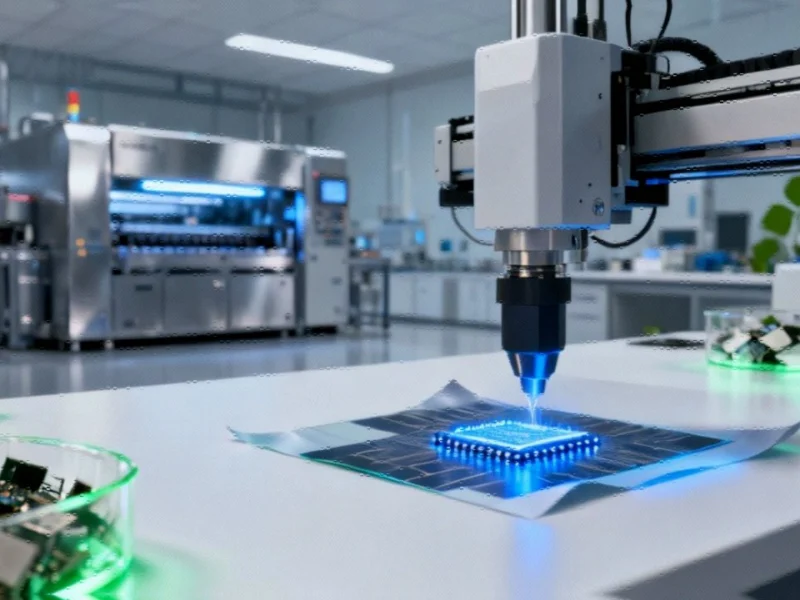Note: Featured image is for illustrative purposes only and does not represent any specific product, service, or entity mentioned in this article.
Breakthrough in Printable Electronics
Duke University researchers have achieved a significant milestone in electronics manufacturing by developing a printing technique capable of producing fully functional, recyclable electronics at sub-micrometer scales. This advancement represents a potential paradigm shift for the $150 billion electronic display industry, offering both environmental benefits and new opportunities for U.S. manufacturing to compete in this vital global market.
The research, published October 17 in Nature Electronics, demonstrates carbon-based transistors that match industry performance standards while being completely recyclable. “If we want to seriously increase U.S.-based manufacturing in areas dominated by global competitors, we need transformational technologies,” said Aaron Franklin, the Edmund T. Pratt, Jr. Distinguished Professor of Electrical & Computer Engineering and Chemistry at Duke.
Addressing Environmental Challenges
The environmental impact of traditional electronics manufacturing is substantial, with vacuum-based processing generating significant greenhouse gas emissions and requiring enormous energy consumption. Compounding this problem, United Nations estimates indicate that less than 25% of the millions of pounds of electronics discarded annually are properly recycled.
Franklin’s laboratory had previously developed the world’s first fully recyclable printed electronics, but those were limited by the 10-micrometer resolution of aerosol jet printing. The new technique overcomes this limitation through what industry experts are calling a breakthrough printing method that enables unprecedented precision in sustainable electronics fabrication.
High Precision Capillary Printing Technology
The research team collaborated with Hummink Technologies to develop “high precision capillary printing” machines that leverage competing surface energies to extract minute amounts of ink from microscopic pipettes. This approach, similar to how paper towels absorb liquid through capillary action, allows for printing features tens of micrometers long with submicrometer gaps between them.
“We sent Hummink some of our inks and had some promising results,” Franklin explained. “But it wasn’t until we got one of their printers here at Duke that my group could harness its real potential.” The researchers utilized three carbon-based inks derived from carbon nanotubes, graphene, and nanocellulose, which can be printed onto various substrates including glass, silicon, paper, and other environmentally friendly surfaces.
Display Industry Applications
The technology’s most immediate application lies in digital displays, where microscopic thin-film transistors (TFTs) control individual pixels. The smaller channel dimensions achieved through this printing method translate to enhanced electrical performance, making the transistors suitable for display backplane control.
While the printed transistors won’t replace high-performance silicon chips in computing applications, Franklin believes they could be transformative for display manufacturing. “These types of fabrication approaches will never replace silicon-based, high-performance computer chips, but there are other markets where we think they could be competitive — and even transformative,” he noted.
This development comes amid broader advanced chip demand trends that are reshaping the semiconductor landscape, though Franklin’s approach targets different market segments with its sustainable focus.
Competitive Advantages and Manufacturing Potential
The printing process offers multiple advantages beyond recyclability, including significantly reduced energy requirements and lower greenhouse gas emissions compared to conventional TFT manufacturing. Franklin considers display fabrication the most feasible large-scale application emerging from his laboratory, though he acknowledges that realizing its full potential requires addressing remaining technical challenges.
The timing of this breakthrough coincides with other significant industry developments in technology research and manufacturing, though the Duke approach stands apart through its environmental focus and printing methodology.
Future Development and Funding Challenges
Despite the promising results, the research faces funding uncertainties. “Unfortunately, the National Science Foundation program that we were pursuing funding from to continue working on this, called the Future Manufacturing program, was cut earlier this year,” Franklin revealed. “But we’re hoping to find a fit in a different program in the near future.”
The research community continues to monitor how such recent technology funding decisions might impact innovation across different sectors, including sustainable electronics manufacturing.
Broader Industry Implications
Beyond display applications, the printing technique could enable higher sensor density in chip footprints, improving accuracy for various electronic devices. The research represents part of a broader movement toward more sustainable electronics manufacturing that aligns with increasing environmental regulations and consumer demand for eco-friendly products.
As the technology sector navigates these changes, observers are also watching how market trends in cloud computing and enterprise technology might influence investment in sustainable hardware innovations.
Franklin remains optimistic about the technology’s prospects: “It’s too promising of a result not to be given further attention.” The combination of competitive performance, environmental benefits, and manufacturing scalability positions this printing technique as a potential catalyst for change in how electronic displays and other components are produced in the future.
This article aggregates information from publicly available sources. All trademarks and copyrights belong to their respective owners.



